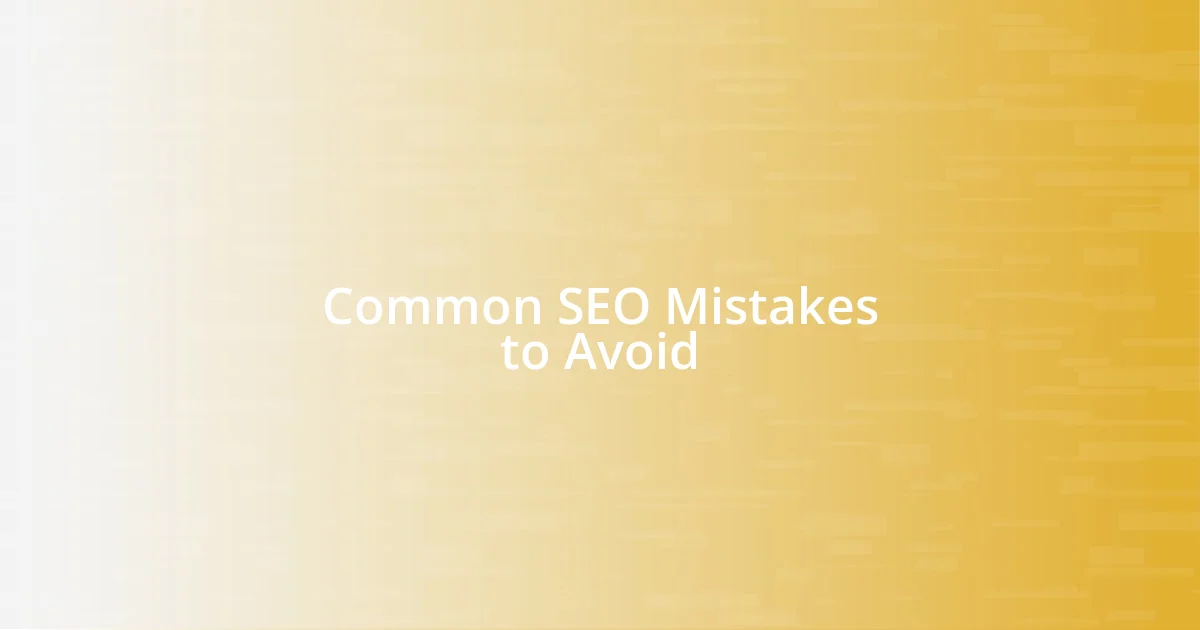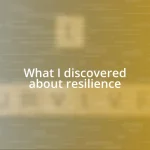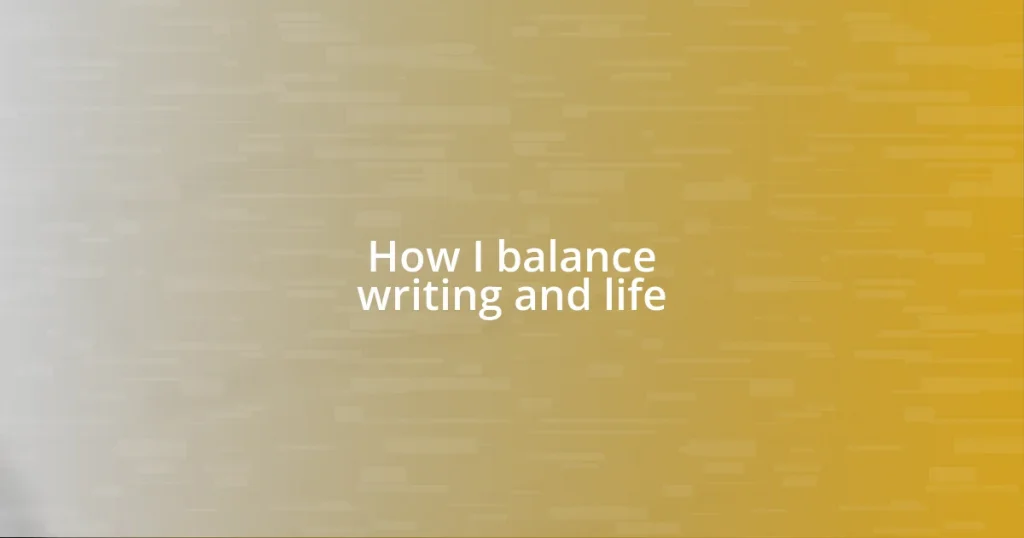Key takeaways:
- Effective SEO revolves around understanding keywords, user intent, and producing quality content that meets audience needs.
- On-page SEO techniques, like optimizing title tags, meta descriptions, and internal linking, significantly enhance visibility and engagement.
- Regularly tracking SEO performance with tools like Google Analytics enables informed strategies and continuous improvement.

Understanding the Basics of SEO
When I first dove into SEO, I was overwhelmed by the terminology and concepts. What helped me was realizing that at its core, SEO is about making your website more user-friendly and accessible to search engines. Have you ever searched for something online and clicked right away on the first result? That’s the goal for every online business.
Keywords are the crux of SEO, acting like a roadmap for both search engines and users. I remember sitting for hours, researching what words people used to find products similar to mine. It’s amazing how a simple word or phrase can shape the traffic flow to your site. Do you know why choosing the right keywords feels like the holy grail of SEO? Because they’re what attracts visitors to your content, guiding them directly to what they’re searching for.
Another essential element to grasp is the importance of quality content. I once posted an article that I thought was solid, only to see it barely generate any traffic. It taught me that search engines prioritize content that meets user intent. This experience really hit home for me—I learned that understanding what your audience wants is key to effective SEO. Have you ever reflected on how much time you spend creating content that doesn’t resonate? It’s a journey of trial and error, but that’s where the real learning happens.

Importance of Keyword Research
Keyword research is the foundation of any successful SEO strategy. From my experience, it’s like striking gold; the right keywords can dramatically increase your visibility online. I still recall the thrill of discovering a set of keywords that dramatically shifted my website’s traffic overnight. It felt like I had unlocked a door to potential customers who were eager for what I offered.
Understanding keyword intent is crucial. For instance, when I started, I often confused informational keywords with transactional ones. This misunderstanding meant I was targeting the wrong audience. When I finally grasped the nuances—like knowing that someone searching “how to bake a cake” is likely looking for a recipe, while “buy cake online” implies intent to purchase—it transformed my approach to content creation. I realized that aligning my content with keyword intent leads to better engagement and conversions.
Moreover, the competitive analysis aspect of keyword research cannot be overlooked. I remember feeling intimidated by established competitors in my niche. However, researching the keywords they were targeting allowed me to identify gaps where I could provide unique value. This not only boosted my confidence but also helped me carve out my own space in a crowded market. It’s an ongoing process, but each insight gained makes me feel more empowered in my online presence.
| Key Insights | Actionable Steps |
|---|---|
| Identify Opportunities | Use tools like Google Keyword Planner to find keywords with high search volume and low competition. |
| Understand User Intent | Create content that specifically meets the needs of your target audience based on their searches. |
| Competitor Analysis | Research top competitors to discover valuable keywords they are targeting that you can leverage. |

On-Page SEO Optimization Techniques
On-page SEO optimization is where the magic happens. I can still remember when I first started tweaking my page elements, and it felt like a secret recipe finally coming together. Making adjustments like optimizing title tags and meta descriptions was enlightening; they serve as crucial invitations for searchers hoping to find value. Each tweak seemed to lift my content to new heights in search results, giving me that rush of motivation to keep going.
Here are some key techniques worth considering for your on-page SEO strategy:
- Title Tags: Ensure your title tag is compelling and includes your primary keyword. This acts as the first impression for searchers.
- Meta Descriptions: Create informative and engaging meta descriptions that summarize your content. A good meta description can significantly increase click-through rates.
- Header Tags: Utilize H1, H2, and H3 tags to structure your content. This not only makes it easier to read but also helps search engines understand the hierarchy of information.
- Image Optimization: Use descriptive file names and alt tags for your images. Not only does this improve accessibility, but it also helps your images rank in search results.
- Internal Linking: Incorporate internal links to connect your content. I’ve found that this not only guides users but also encourages them to explore more pages, reducing bounce rates.
- Content Readability: I’ve learned that clear and concise content resonates better. Break up blocks of text and use bullet points, like this one, to enhance readability.
Paying attention to these aspects made a noticeable difference in my SEO journey. It’s like cultivating a garden; you nurture specific areas, and soon, everything flourishes.

Off-Page SEO Strategies for Beginners
Off-page SEO is fascinating because it emphasizes building your website’s reputation and authority beyond your own domain. One strategy I found incredibly impactful is cultivating backlinks. In my early days, I underestimated the power of quality backlinks. I remember connecting with other bloggers in my niche, and it felt like building a community rather than just chasing numbers. Those connections not only led to valuable link placements but also created genuine relationships that enhanced my credibility.
Another essential off-page strategy is engaging in social media. When I first delved into social platforms, I was unsure how they could influence my SEO efforts. However, I learned that sharing my content and engaging with my audience helped drive traffic to my site. Whenever I posted anything valuable, the likes and shares felt like little victories, boosting my confidence and expanding my reach. It’s such a thrill to witness your content resonate with others!
Moreover, participating in online forums and communities can do wonders for your SEO. I recall joining niche-related groups and actively contributing. Not only did it position me as an authority, but it also resulted in some unexpected traffic spikes. I noticed that answering questions and providing helpful insights led people back to my site, making me realize how powerful community engagement can be. Have you experienced this? It’s truly rewarding to share knowledge and see it positively impact your online presence.

Tracking SEO Performance Effectively
Tracking SEO performance isn’t just an afterthought; it’s a crucial part of your SEO journey. From my experience, Google Analytics and Google Search Console are indispensable tools. While diving into my analytics for the first time, I remember the initial confusion quickly transforming into excitement when I saw tangible results. Tracking metrics like organic traffic and click-through rates not only informed my strategies but also fueled my passion to keep learning and adapting.
Setting specific goals is another step that revolutionized how I approach SEO. I made the mistake early on of not identifying clear objectives, which led to overwhelming data that didn’t resonate with my aspirations. After I started tracking metrics like conversion rates and keyword rankings, I felt more empowered. It was like having a map during a road trip; I could see where I was going and make informed detours to reach my destination.
Moreover, regularly reviewing and adjusting my strategy based on performance data has been a game changer. I vividly recall a time when I noticed a drop in rankings for a specific keyword. Instead of panicking, I analyzed my content and the competition. This inspection revealed areas for improvement, and after fine-tuning my page, I witnessed a resurgence in both traffic and rankings. Have you ever experienced such a turnaround? It’s both nerve-wracking and exhilarating to realize that with data-driven decisions, you hold the reins to your SEO success.

Common SEO Mistakes to Avoid
One common mistake I frequently see beginners make is neglecting keyword research. Early on in my SEO journey, I remember writing content that resonated with me, but it hardly aligned with what my audience was searching for. It was a tough pill to swallow when I realized my heartfelt posts weren’t getting the traffic they deserved. I learned that using tools like Google Keyword Planner could help me find the right words to attract the audience I wanted. Have you ever published something you thought was perfect, only to find it falling flat? It’s crucial to strike that balance between passion and strategy.
Another pitfall involves overlooking on-page SEO elements. I used to think that as long as my content was great, the technical aspects didn’t matter much. However, when I started optimizing my titles, meta descriptions, and header tags, the impact was immediate. Engaging titles drew readers in, while well-structured content significantly improved my bounce rate. Have you ever landed on a page with a confusing layout? It’s clear how important these aspects can be for keeping visitors engaged.
Finally, don’t forget about the mobile experience. I can vividly recall a time when I checked my site’s performance and was shocked to see a drop in mobile traffic. I realized I hadn’t prioritized mobile optimization. In today’s world, most users browse on their phones, so if your site isn’t mobile-friendly, you’re likely losing valuable visitors. I took the plunge to redesign my site for better mobile accessibility, and the difference was astonishing. Have you ever tried navigating a desktop site on your phone? It’s frustrating! Making your site accessible to all devices isn’t just a suggestion; it’s an essential part of a successful SEO strategy.















